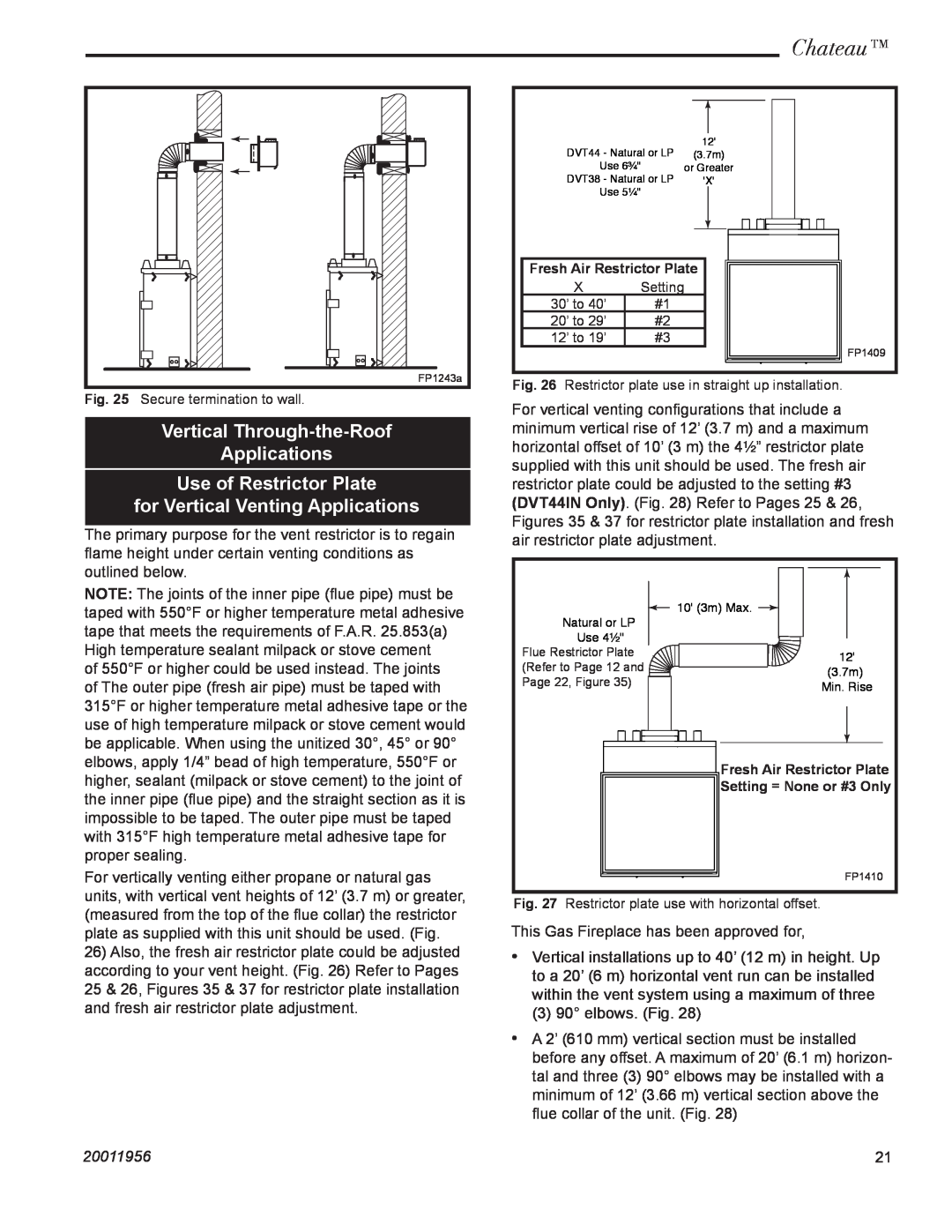
FP1243a |
Fig. 25 Secure termination to wall.
Vertical Through-the-Roof
Applications
Use of Restrictor Plate
for Vertical Venting Applications
The primary purpose for the vent restrictor is to regain flame height under certain venting conditions as outlined below.
NOTE: The joints of the inner pipe (flue pipe) must be taped with 550°F or higher temperature metal adhesive tape that meets the requirements of F.A.R. 25.853(a) High temperature sealant milpack or stove cement
of 550°F or higher could be used instead. The joints of The outer pipe (fresh air pipe) must be taped with 315°F or higher temperature metal adhesive tape or the use of high temperature milpack or stove cement would be applicable. When using the unitized 30°, 45° or 90° elbows, apply 1/4” bead of high temperature, 550°F or higher, sealant (milpack or stove cement) to the joint of the inner pipe (flue pipe) and the straight section as it is impossible to be taped. The outer pipe must be taped with 315°F high temperature metal adhesive tape for proper sealing.
For vertically venting either propane or natural gas units, with vertical vent heights of 12’ (3.7 m) or greater, (measured from the top of the flue collar) the restrictor plate as supplied with this unit should be used. (Fig.
26)Also, the fresh air restrictor plate could be adjusted according to your vent height. (Fig. 26) Refer to Pages 25 & 26, Figures 35 & 37 for restrictor plate installation and fresh air restrictor plate adjustment.
Chateau™
DVT44 - Natural or LP | 12' |
| ||
(3.7m) | ||||
Use 6���" | or Greater | |||
DVT38 - Natural or LP |
| 'X' | ||
Use 5���" |
|
|
|
|
|
|
|
|
|
|
|
|
|
|
Fresh Air Restrictor Plate
XSetting
30’ to 40’ | #1 |
20’ to 29’ | #2 |
12’ to 19’ | #3 |
FP1409
Fig. 26 Restrictor plate use in straight up installation.
For vertical venting configurations that include a minimum vertical rise of 12’ (3.7 m) and a maximum horizontal offset of 10’ (3 m) the 4¹⁄₂” restrictor plate supplied with this unit should be used. The fresh air restrictor plate could be adjusted to the setting #3 (DVT44IN Only). (Fig. 28) Refer to Pages 25 & 26, Figures 35 & 37 for restrictor plate installation and fresh air restrictor plate adjustment.
10' (3m) Max.
Natural or LP
Use 4���"
Flue Restrictor Plate | 12' | |
(Refer to Page 12 and | ||
(3.7m) | ||
Page 22, Figure 35) | ||
Min. Rise | ||
|
![]() Fresh Air Restrictor Plate Setting = None or #3 Only
Fresh Air Restrictor Plate Setting = None or #3 Only
FP1410
Fig. 27 Restrictor plate use with horizontal offset.
This Gas Fireplace has been approved for,
•Vertical installations up to 40’ (12 m) in height. Up to a 20’ (6 m) horizontal vent run can be installed within the vent system using a maximum of three
(3) 90° elbows. (Fig. 28)
•A 2’ (610 mm) vertical section must be installed before any offset. A maximum of 20’ (6.1 m) horizon- tal and three (3) 90° elbows may be installed with a minimum of 12’ (3.66 m) vertical section above the flue collar of the unit. (Fig. 28)
20011956 | 21 |
